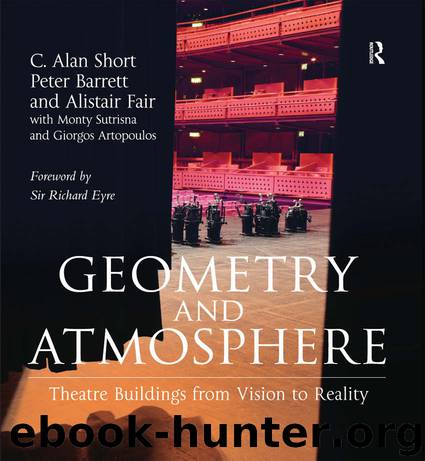Geometry and Atmosphere: Theatre Buildings from Vision to Reality by Short C. Alan & Barrett Peter & Fair Alistair & Sutrisna Monty

Author:Short, C. Alan & Barrett, Peter & Fair, Alistair & Sutrisna, Monty [Short, C. Alan]
Language: eng
Format: epub
Publisher: Taylor and Francis
Published: 2016-12-05T05:00:00+00:00
Fig. 5.20 The auditorium re-imagined in response to Hamish Glen’s ideas
Fig. 5.21 ‘An industrial space for theatre-makers to transform’
Fig. 5.22 A found space: the seating and staging structure was inserted within the volume of the auditorium
BUILDING THE THEATRE
By the time at which a decision was reached on the auditorium arrangement, construction work was in fact underway. This section of the chapter summarizes the history of the project from the point at which it began on site in the summer of 2005 to its completion in the summer of 2007. Once again, certain themes are to the fore: rising costs, team relationships, and the specificities of programming construction work in the arts sector. Coupled to these themes are the related general issues of joining new buildings to old, and the unpredictability of construction, both of which had significant impacts on the programme and on the way in which the eventual scheme was delivered.
The second half of 2005 was characterized by detailed design work, not least where the revised auditorium was concerned, accompanied by further and repeated Value Engineering exercises as the Belgrade sought to counter constantly rising costs with savings. The process affected all aspects of the design detail, though the overall concept was fiercely guarded. As Pettitt put it:
We as a company have had to re-address the way that we design, to make it appropriate but still give it the strength and power and coherence that’s wanted, but perhaps not with [the] materials and detailing we would first envisage . 115
In contrast to the earlier stages of the project, where Value Engineering was focussed on removing parts of the scope of works, in these later stages cost savings were largely made by changes to materials and finishes. Externally, render and polycarbonate were deployed for their low cost, and the glazing of the new theatre entrance (one of the more expensive elements of the external design) was achieved more cheaply through the ingenious use of a standard system (fig. 5.23 ). Glen became concerned that the reductions were increasingly affecting the quality of the project: ‘the punters … don’t see the M&E [mechanical and electrical] work, they see the finish! ’ 116 But reductions were necessary if the power of the original concept was to be retained, while at this late stage it would have been difficult to remove further spaces or much in the way of technical equipment from the brief without damaging the viability of the completed scheme. The ultimate scope was developed through negotiation with the architects and the contractors, evaluating which elements might be reduced or altered, and which were sacrosanct.
Download
This site does not store any files on its server. We only index and link to content provided by other sites. Please contact the content providers to delete copyright contents if any and email us, we'll remove relevant links or contents immediately.
Aircraft Design of WWII: A Sketchbook by Lockheed Aircraft Corporation(32139)
The Great Music City by Andrea Baker(30794)
Call Me by Your Name by André Aciman(19915)
The Art of Boudoir Photography: How to Create Stunning Photographs of Women by Christa Meola(18410)
The Secret History by Donna Tartt(18190)
Shoot Sexy by Ryan Armbrust(17560)
Plagued by Fire by Paul Hendrickson(17117)
Portrait Mastery in Black & White: Learn the Signature Style of a Legendary Photographer by Tim Kelly(16873)
Adobe Camera Raw For Digital Photographers Only by Rob Sheppard(16800)
Photographically Speaking: A Deeper Look at Creating Stronger Images (Eva Spring's Library) by David duChemin(16501)
Ready Player One by Cline Ernest(14005)
Pimp by Iceberg Slim(13789)
Bombshells: Glamour Girls of a Lifetime by Sullivan Steve(13692)
The Goal (Off-Campus #4) by Elle Kennedy(13207)
Art Nude Photography Explained: How to Photograph and Understand Great Art Nude Images by Simon Walden(12855)
Kathy Andrews Collection by Kathy Andrews(11331)
The Priory of the Orange Tree by Samantha Shannon(8628)
Thirteen Reasons Why by Jay Asher(8461)
The remains of the day by Kazuo Ishiguro(8403)
